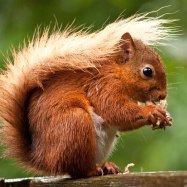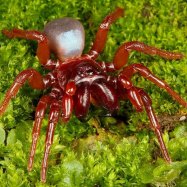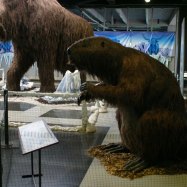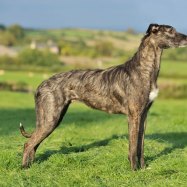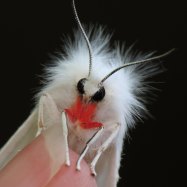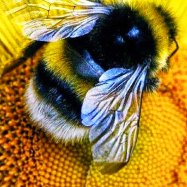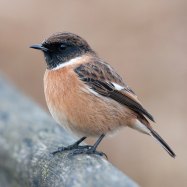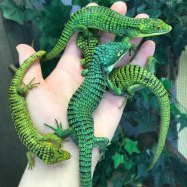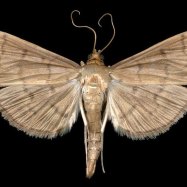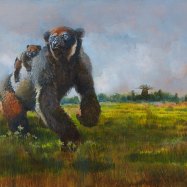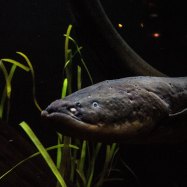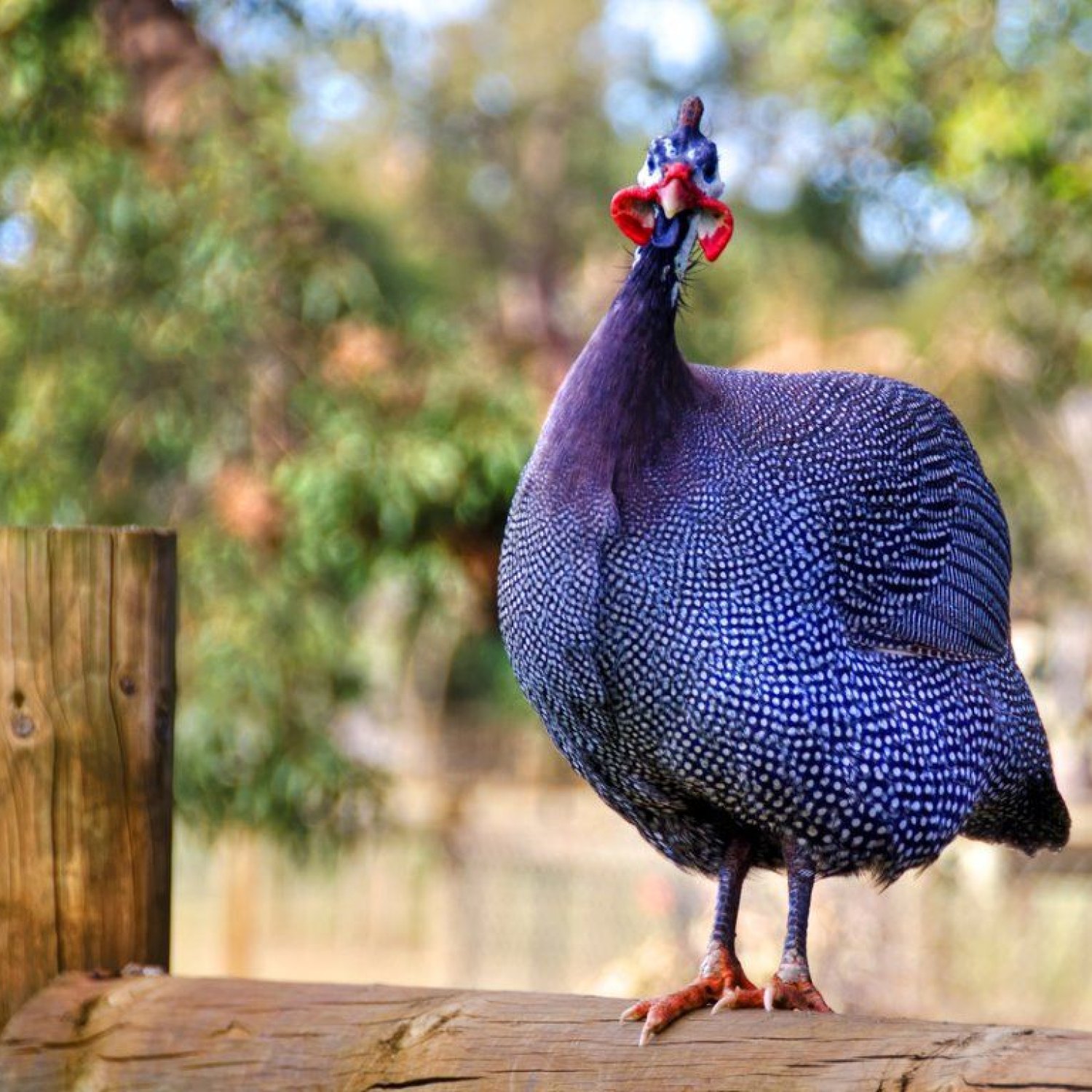
Guinea Fowl
45-60 cm (18-24 in)
The Guinea Fowl, native to Sub-Saharan Africa, is a medium-sized bird with a plump body and small head. Typically found in the wild, they can also be seen worldwide in captivity. Ranging from 45-60 cm in length, these birds belong to the Numididae family and are known for their vibrant and unique feather patterns. With their docile nature and adaptability, they make great additions to any aviary. #GuineaFowl #SubSaharanAfrica #Birds #Numididae
Animal Details Summary:
Common Name: Guinea Fowl
Kingdom: Animalia
Habitat: Grasslands, savannas, and woodlands
The Fascinating Natural World of Guinea Fowl
If you have ever strolled through the African savanna, you may have been serenaded by the distinct sounds of the Guinea fowl. These curious birds with their striking black, white, and gray feathers and peculiar calling sound are a common sight in their native land. Despite being found in different regions worldwide, these birds are truly a unique and interesting species. In this article, we will explore the fascinating natural world of Guinea fowl, from their physical characteristics to their behavior and habitat Guinea Fowl.Known scientifically as Numida meleagris, the Guinea fowl belongs to the class Aves, meaning they are birds. They are a part of the Galliformes order, which includes other familiar birds such as chickens, turkeys, and pheasants. They are from the family Numididae and are commonly referred to as Guinea fowl, a name derived from their origin in Guinea, a country in West Africa.
Guinea fowls are medium-sized birds, with a plump body, short wings, and a small head in comparison. They can grow to a length of 45-60 cm (18-24 in) and weigh between 1-1.5 kg (2.2-3.3 lbs). Their most striking feature is their unique feather patterns, which consist of black, white, and gray colors in various combinations Gollie. This feather pattern serves as camouflage in their natural habitat, allowing them to blend in with the grasslands and woodlands where they are found.
Being adaptive animals, Guinea fowl can survive in different habitats, including grasslands, savannas, and woodlands. They are also found in tropical and subtropical regions across Africa, making their geographical distribution quite extensive. However, their native country is in sub-Saharan Africa, where they can be observed living in the wild. They are mostly ground dwellers but are also capable of limited flight, making them somewhat of an intermediate bird species.
Now that we have covered some basic information about Guinea fowl let's dive deeper into their fascinating world and uncover more interesting details about these birds.
The Habitat of Guinea Fowl
As mentioned earlier, Guinea fowl are highly adaptable birds and can thrive in different habitats. However, they are commonly found in areas with a combination of grasslands, woodlands, and savannas. These birds also prefer areas with tall grasses for cover and bountiful trees for roosting and nesting purposes. Their natural habitats provide them with ample food sources, shelter, and protection from predators.In the wild, Guinea fowl are found throughout sub-Saharan Africa, specifically in countries such as Ghana, Nigeria, and Kenya. They often form flocks of up to 50 birds, known as confederacies, which allows them to forage for food and roost together for safety. These flocks, sometimes referred to as "speckled parties," can often be heard making their unique calling sounds as they wander through the savanna.
In captivity, Guinea fowl can be found worldwide, especially in countries with warmer climates. They are popular birds among farmers and homesteaders due to their efficient pest control capabilities. These birds have a voracious appetite for insects, snails, and even small reptiles. This natural feeding method makes them valuable in controlling pest populations on farms and in gardens.
The Omnivorous Eating Habits of Guinea Fowl
As mentioned earlier, Guinea fowl are omnivorous birds, which means they consume both plant and animal matter. In the wild, they mainly feed on insects, worms, snails, and small reptiles. They also have a liking for plant matter, including seeds, berries, and roots. These birds use their powerful beaks to forage for food, and their keen sense of sight allows them to spot even the tiniest insects.In captivity, their diet is usually supplemented with a mix of grains, vegetables, and protein sources, making them a valuable source of sustainable food for humans. They are also known to eat the ticks off of cattle, making them popular among farmers as natural pest control.
The Role of Guinea Fowl in Their Ecosystem
Beyond their use in agriculture, Guinea fowl also play a significant role in their ecosystem. As ground-dwelling birds, they aid in seed dispersal and contribute to the soil's aeration through their foraging activities. They also act as prey for larger animals, balancing the food chain in their habitats.Their unique patterns and behaviors also make them a subject of study for ecologists and ornithologists. Through research and observation, we continue to learn more about these birds and their impact on their environment.
The Social Behavior of Guinea Fowl
Guinea fowl are social birds and prefer to live in groups, usually consisting of a dominant male and several females. However, they are also known to form alliances with other flocks and are quite vocal when they encounter other groups. As mentioned earlier, these groups are called confederacies or speckled parties. Their unique calling sounds serve as a form of communication within their groups and can signal danger or gather attention from other members of the flock.Conservation Efforts for Guinea Fowl
Despite being considered a species of least concern by the International Union for Conservation of Nature, Guinea fowl populations have been affected by urbanization, farming practices, and the pet trade. In some areas, they are hunted for their meat and feathers, leading to a decline in their numbers.To counter these threats, conservation efforts have been put in place to protect Guinea fowl populations and their habitats. Various organizations work to educate communities on the importance of preserving these birds and their ecosystems. Some programs also focus on captive breeding and reintroduction of Guinea fowl in areas where their populations have declined.
The Human-Guinea Fowl Interaction
Guinea fowl have a long history of interaction with humans, dating back to ancient civilizations in Africa. These birds were often domesticated for food and their alarm calls, which served as a warning for potential predators. In some cultures, they were also used for divination, and their feathers were considered sacred for rituals and ceremonies.Today, Guinea fowl continue to have a significant impact on human lives. They are domesticated for their meat, eggs, and pest control abilities. They are also a source of income for rural communities through the sale of their feathers and live birds. Their unique and striking appearance also makes them a popular subject for arts and crafts.
The Role of Guinea Fowl in Sustainable Agriculture
One of the most valuable roles of Guinea fowl in human society is their contribution to sustainable agriculture. As natural pest controllers, these birds help reduce the use of harmful chemicals and pesticides in farming. Their efficient insect and weed control methods make them an essential tool for organic farmers and gardeners.Farmers also use Guinea fowl as a means of free-range insect control, as they are able to forage for food without damaging crops. This has a positive impact on the environment and human health, making Guinea fowl an important part of sustainable agriculture practices.
In addition to their pest control capabilities, Guinea fowl also provide organic fertilizers in the form of their droppings. Their manure is rich in nitrogen and other nutrients, making it an excellent natural fertilizer for gardens and farms.
The Fascinating World of Guinea Fowl
In conclusion, Guinea fowl may seem like ordinary birds at first glance, but they are truly fascinating creatures with unique features and behaviors. From their striking feather patterns to their social behaviors and contribution to sustainable agriculture, Guinea fowl play a significant role in their ecosystems and human society. As we continue to learn more about these birds and their importance, it is crucial to protect and preserve their habitats and populations for future generations to experience the fascinating world of Guinea fowl.

Guinea Fowl
Animal Details Guinea Fowl - Scientific Name: Numida meleagris
- Category: Animals G
- Scientific Name: Numida meleagris
- Common Name: Guinea Fowl
- Kingdom: Animalia
- Phylum: Chordata
- Class: Aves
- Order: Galliformes
- Family: Numididae
- Habitat: Grasslands, savannas, and woodlands
- Feeding Method: Omnivorous
- Geographical Distribution: Africa
- Country of Origin: Africa
- Location: In the wild: Sub-Saharan Africa In captivity: Worldwide
- Animal Coloration: Feathers with black, white, and gray coloration
- Body Shape: Medium-sized bird with a plump body and a small head
- Length: 45-60 cm (18-24 in)
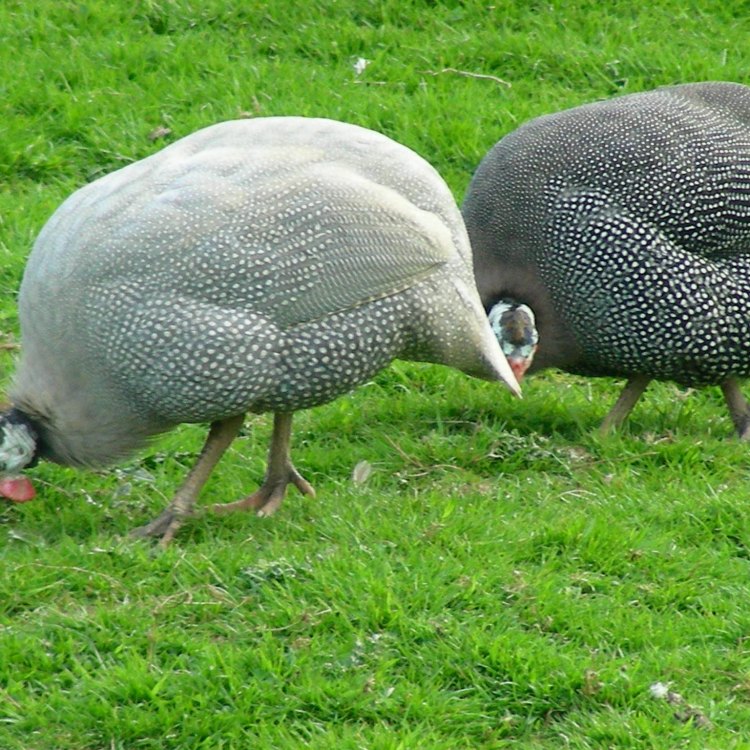
Guinea Fowl
- Adult Size: Small to medium-sized
- Average Lifespan: 10-15 years in the wild; up to 20 years in captivity
- Reproduction: Sexual reproduction
- Reproductive Behavior: Male courtship displays, female choice
- Sound or Call: Loud, repetitive calls
- Migration Pattern: Some populations are migratory
- Social Groups: Form flocks
- Behavior: Diurnal
- Threats: Habitat loss, hunting
- Conservation Status: Least Concern
- Impact on Ecosystem: Seed dispersal, insect control
- Human Use: Meat, eggs, feathers
- Distinctive Features: Bare head and neck, spiky feathers on the back
- Interesting Facts: 1. They are excellent at controlling pest populations. 2. Their eggs have harder shells than chicken eggs. 3. They are known for their loud and distinctive calls.
- Predator: Carnivorous mammals, birds of prey
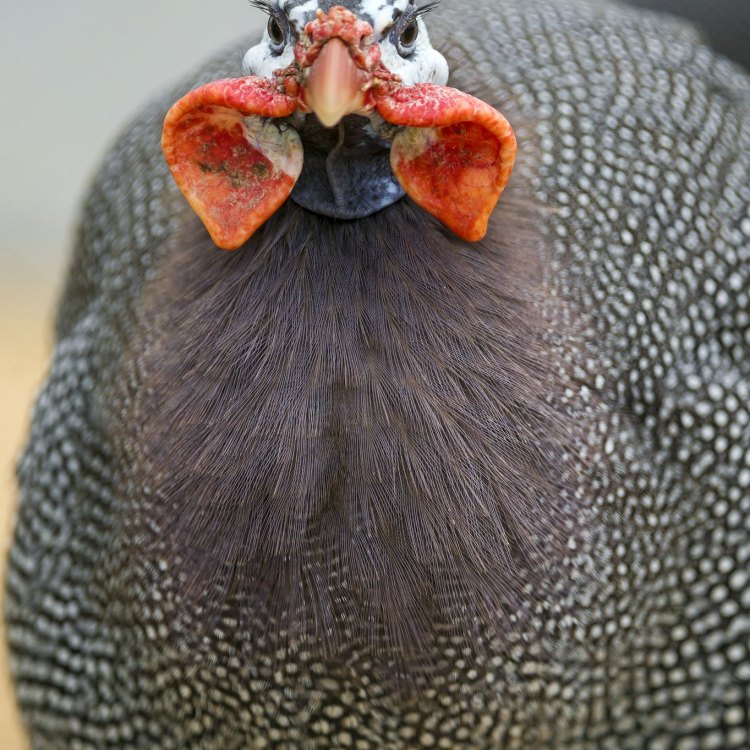
Numida meleagris
The Fascinating World of Guinea Fowl: Unique Features and Role in Ecosystem
The sun was just starting to rise over the African savannah, painting the sky in shades of orange and pink. As the world stirred to life, a distinct call cut through the morning air, signaling the start of a new day. It was the call of the guinea fowl, a small to medium-sized bird native to Africa and one that has captivated humans for centuries.From their distinctive appearance to their integral role in the ecosystem, guinea fowl have several unique features that make them stand out among other species PeaceOfAnimals.Com. In this article, we will explore these features and shed light on the lesser-known aspects of these intriguing birds.
The Basics: Adult size, lifespan, and reproductive behavior
Guinea fowl are small to medium-sized birds, with adults averaging 16-28 inches in length and weighing about 2.5 pounds. They are a sexually dimorphic species, meaning males and females have different physical characteristics. The males are larger and more colorful, while females are slightly smaller and adorned with more muted colors.In the wild, guinea fowl have an average lifespan of 10-15 years, but in captivity, they can live up to 20 years. These birds are sexually reproductive, meaning they require both a male and female to produce offspring. Reproduction usually occurs during the rainy season when food is plentiful and the environment is most conducive for raising young.
Reproductive behavior: Courtship displays and female choice
In the world of guinea fowl, it is the males who put on a show to attract a mate Great Egret. During the breeding season, male guinea fowl engage in elaborate courtship displays to woo potential partners. These displays can include puffing up their chest, shaking their feathers, and strutting around in front of the females in an attempt to impress them.But despite the males' best efforts, it is ultimately the female's choice to accept a mate or not. Female guinea fowl will observe the male's behavior and select a mate based on his strength, dominance, and overall fitness. Once a pair has bonded, they will remain monogamous for the duration of the breeding season.
Their distinctive calls: loud and repetitive
One of the most distinctive features of guinea fowl is their loud and repetitive calls. These birds are known for their chattering, honking, and screeching, which can be heard from miles away. The calls serve multiple purposes, including communication between flock members, warning signals for potential danger, and as a way to attract a mate.Their complex vocalizations have also led to their name "guinea" fowl, as their sounds have been compared to the grunts and squeals of a pig, a common domestic animal in Guinea, Africa.
Migration patterns and social groups: Flocking together
While some populations of guinea fowl are migratory, meaning they travel from one place to another in search of food and better living conditions, others are non-migratory and remain in their home territories year-round.But regardless of their migratory status, guinea fowl are social birds and gather in flocks of up to 25 individuals. These flocks often consist of multiple adult pairs and their offspring. The strong social bonds within the flocks contribute to the survival and successful reproduction of the species.
Behavior: Active during the day
Guinea fowl are diurnal birds, meaning they are most active during the day and spend their nights roosting in trees or shrubs. They are ground-dwelling birds and can often be seen scratching and pecking at the ground in search of food.One of their unique behaviors is their ability to perch on low-hanging branches and clamber through bushes, making them excellent foragers. This behavior also allows them to evade predators and escape danger quickly.
Threats to Survival: Habitat loss and hunting
Like many other animal species, guinea fowl face several threats that impact their survival. One of the main causes of their decline is habitat loss. As human populations continue to expand and encroach on natural habitats, the guinea fowl's home range diminishes, leaving them with less food and shelter.Another major threat to their survival is hunting, both for their meat and their feathers. Guinea fowl are considered a delicacy in many African countries, and their feathers are used for various crafts and decorations. This hunting pressure has led to a decline in their populations, particularly in areas where they are heavily hunted.
Conservation Status and Impact on the Ecosystem
Despite the threats they face, guinea fowl are currently listed as a species of Least Concern on the IUCN Red List, meaning they are not currently at risk of extinction. However, their populations are decreasing, and continued efforts are needed to protect and preserve these birds for future generations.One of the reasons guinea fowl are essential for ecosystem health is their role in seed dispersal. When foraging for food, these birds will often consume various fruits and seeds, which then pass through their digestive system and are dispersed in new locations. This process helps to maintain plant diversity and ensures the growth of new vegetation.
Additionally, guinea fowl play a crucial role in insect control. They are known for their voracious appetite for insects, which helps to keep pest populations in check and maintain a balance in the ecosystem.
Human use of Guinea Fowl: More than just meat and eggs
Guinea fowl have been domesticated for thousands of years and have been used by humans for food, feathers, and even as pets. Their meat is prized for its rich flavor, and their eggs have harder shells and a robust yolk compared to chicken eggs, making them popular among gourmet chefs.Apart from their use as food, guinea fowl feathers are also highly valued. They are often used for fly tying lures, and their speckled pattern is a sought-after material for fashion and home decor items.
Interestingly, these birds are also used for their insect control abilities. Many farmers include guinea fowl in their flocks to control pest populations in their fields, reducing the need for harmful pesticides.
Distinctive Features: Bare head and neck, and spiky feathers
One of the most striking features of guinea fowl is their bare head and neck. Unlike most birds, whose heads are adorned with feathers, guinea fowl have a small patch of blue and red skin on their head, which is often used in their courtship displays.Their feathers are also unique, with a spiky appearance on their back, earning them the nickname "helmeted fowl." These feathers are not only for decoration but also serve as protection against predators.
Interesting Facts: Pest Controllers, hardy eggs, and more
In addition to their distinctive features, guinea fowl have several interesting facts that make them truly unique. Here are three of them:- One of the most significant benefits of having guinea fowl around is their ability to control pests. These birds are particularly good at targeting insects like ticks, locusts, and ants, making them a natural and sustainable solution for pest control in agriculture.
- Guinea fowl eggs have a notoriously hard shell, making them difficult to crack. This resistance helps to protect the developing embryo from harm, giving them a higher chance of survival compared to other birds.
- While guinea fowl are known for their loud and repetitive calls, they also have a quieter side. They have a softer, more musical call that they use to communicate with their young while foraging.
Predators: Carnivorous mammals and birds of prey
Despite their ability to evade danger with their quick reflexes and loud alarm calls, guinea fowl face several predators in the wild. Their main predators include carnivorous mammals such as foxes, jackals, and mongoose, and birds of prey like eagles and hawks.However, these birds have also developed unique behaviors to protect themselves from predators, such as flocking together and roosting high off the ground at night.
In Conclusion
In conclusion, the guinea fowl is a fascinating and unique bird species with several distinctive features and behaviors. Whether it's their bare head and neck, their loud calls, or their role in the ecosystem, guinea fowl continue to capture the attention of humans worldwide.Despite the threats they face, it is crucial to protect and preserve these birds for future generations to enjoy. So, the next time you hear their unmistakable calls, take a moment to appreciate these feathered wonders and their place in the delicate balance of the ecosystem.
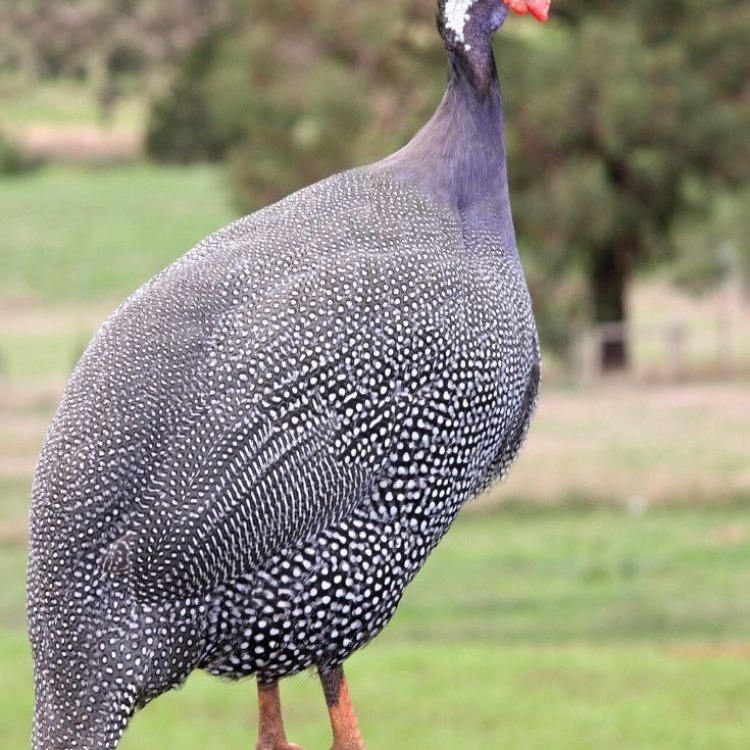
The Fascinating Natural World of Guinea Fowl
Disclaimer: The content provided is for informational purposes only. We cannot guarantee the accuracy of the information on this page 100%. All information provided here may change without prior notice.

